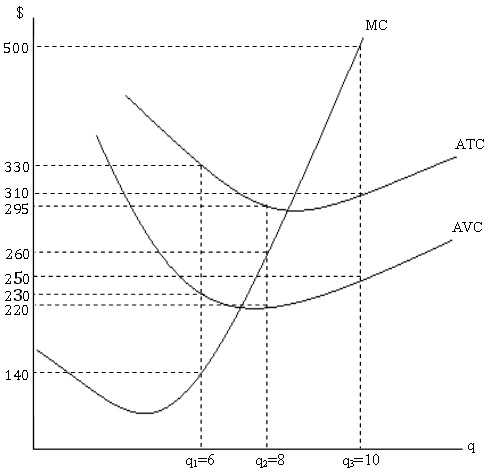Question 1. Suppose there is a perfectly competitive industry with a market demand curve that can be expressed as:
P = 100 – (1/10)Q
where P is the market price and Q is the market quantity. Furthermore, suppose that all the firms in this industry are identical and that a representative firm’s total cost is:
TC = 100 + 5q + q2
where q is the quantity produced by this representative firm. The representative firm’s marginal cost is: MC = 5 + 2q.
a. What is the average total cost for the representative firm?
b. In the long run, how many units will this firm produce and what price will it sell each unit for in this market?
c. What is the total market quantity produced in this market in the long run?
d. How many firms are in th e industry in the long run?
e. How do short - run profits change for the firm if demand decreases? Increases?
f. How do long - run profits change for the firm if demand decreases? Increases?
Question 2. Consider another perfectly competitive industry with a market demand curve given as:
Q = - 2P + 1,000
Again, suppose that all the firms in this industry are identical. But now, we do not know the total cost, instead we know that the long run average total cost for a representative firm in the industry is: LRATC = q2 – 10q + 100. And each firm’s marginal cost is given by: MC = 3q2 – 20q + 100.
a. In the long run, how many units will a representative firm produce and what price will it sell each unit for in this market?
b. How many firms are in the industry in the long run?
c. Suppose there is an increase in the market demand for the good. The new demand curve is given by:
Qnew = - 2P + 1,196.
Briefly describe what will happen to the existing firms' profit in the short run and the number of firms in the industry in the long run. d. In the short run, each firm’s supply curve will be its marginal cost curve. Suppose we know that each firm will produce 6 units in the short run. What is a representative firm’s short run profits?
e. In the long run, approximately how many new firms will enter?
Question 3. Use the graph below to answer the following questions.

a. Find (i) variable cost, (ii) fixed cost, (iii) total cost, and (iv) profits at output levels q1 , q2 , and q3 .
b. At which of the output levels (q1 , q2, and q3) wi ll the firm operate in the short run?
c. At which of the output levels (q1 , q2 , and q3) will t he firm operate in the long run?
Question 4. In each of the following questions, draw MC, ATC, AVC, and any other things relevant to the question in addition to answering in words.
a. How can you find the supply curve for a firm in the short run? Label the SR supply curve on your graph.
b. Suppose you know that the price level is below average variable cost. Label such a price on your graph. Also, show where this price lies on the SR supply curve or explain why you cannot. What does price being below AVC mean for a firm in the short run?
c. Suppose that the firm is earning positive profits in the short run. On a separate graph, label a possible price on your graph that would give posit ive profits and shade the area representing the firm’s profits.
d. Suppose that the firm is earning negative profits in the short run. On a separate graph, label a possible price that would give negative profits and shade the area representing the firm’s los ses. Why does the firm continue operating in the short run, even though it is making negative profits? Compare these losses to the firm’s losses if it shuts down in the short run.
e. Suppose now you are looking at the long run. Using the original setup, add t he long run average cost curve. At what price will a firm shut down in the long run? Label this point on your graph.
Question 5. A firm in the textbook industry has the total cost function TC = 40 + 100q + 10q2, and the marginal cost function MC = 100 + 20q.
a. What are the firm’s fixed costs?
b. What is the firm’s variable cost curve?
c. What is the firm’s average variable cost curve?
d. In the short run, this firm will produce a positive quantity as long as the price is larger than what?
e. At what price will t he f irm’s total profits be equal to zero?